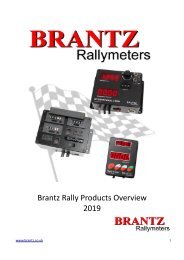Brantz Rally Product Overview - 2020
The Brantz brand of rally equipment offers the complete range of motorsport Tripmeters and Retrotrips for everyone from novice rally enthusiasts all the way to professional team rallying.
The Brantz brand of rally equipment offers the complete range of motorsport Tripmeters and Retrotrips for everyone from novice rally enthusiasts all the way to professional team rallying.
You also want an ePaper? Increase the reach of your titles
YUMPU automatically turns print PDFs into web optimized ePapers that Google loves.
Which Sensor?
Brantz Rally Tripmeters require a sensor to send travel information up to the instrument so that it can calculate
and display just how far the vehicle has travelled.
The most suitable sensor is chosen from a few key factors pertaining to the vehicle that the tripmeter is being installed
into.
The criteria are:
1. Positioning – You need to be able to access your sensor, but you don’t want it easily dislodged or knocked
2. Accuracy - Different sensor types may give you different calibration figures and possibly increased accuracy
for your particular vehicle
3. Ease of Fitting – Do you prefer mechanical or electrical if that is an option. Or even Plug & Go if allowed.
4. Cost Considerations - Remember the cost includes fitting time and servicing time.
The first choice is the screw-on gearbox sensor that fits between your gearbox and Speedo Cable this option is the
fastest and easiest to fit. It has great reliability as it is not near high heat sources or in the path of flying under-car
debris.
Some of the types we are stock are;
BR3: M22 Japanese Gearbox Sensor with a Pinched Pin Drive
BR3-HG-2: M22 High Grade Japanese Gearbox Sensor with 2 Drive Pin Styles (Pinched Pin or Spade)
BR3-SQ: M22 Gearbox Sensor with a Square Pin Drive
BR4: M18 European Gearbox Sensor with a Square Pin Drive
If you have a different variation of gearbox thread than our standard fittings above, please feel free to contact us
with the thread, pitch and drive pin shape of your speedo-cable feed as we can source alternative sizes.
If the vehicle has a mechanically driven speedometer but is not suitable for a gearbox sensor, if space is
limited or on older British cars with imperial gearbox thread, then your options are BR1: Universal
Speedometer Cable sensor which fits in the length of the existing speedometer cable. This choice will
require the removal of the speedo cable and cutting of the speedo cable sleeving, which is a little more
effort, but is an excellent and common choice. Alternatively the BRM12: Smith/Jaeger Speedometer
Sensor, which will fit most of the Smiths and Jaeger Speedometers apart from the very early ones.
The first generation of cars which had an electronically driven speedometer (i.e. there was no mechanical
cable) generated pulses from a device screwed onto the gearbox where the old cable once went, or
from a dedicated sender built into the transmission chain. They are three-wire devices; one wire being
ground, one wire being +12v power when the ignition key is ON, and the one wire we are interested in,
which has a digital signal on it. The voltage on this wire if viewed by a voltmeter will go up to 12volts and
down to ground a few times per revolution of the transmission. For these vehicles the sensor would be a
BR5: Electronic Speedo Interface. Connect the digital signal wire mentioned above to the single terminal
end of the BR5 interface. The other end of the interface goes to the tripmeter. The BR5 will prevent
the car and the tripmeter from damaging each other. Additionally the BR5 allows a very high pulse rate
source (such as for some Astra cars) to be divided down to a reasonable pulse rate so that our tripmeters
can calibrate in the normal range. Very quick and easy to fit.
Rally cars competing on loose surfaces use a lot of wheel spin at the driven wheels. This scenario dictates
that for accuracy the tripmeter will need to pick up from a non-driven wheel using the BR2A:
Wheel Sensor. For hot climates and runs with increased amounts of braking we would recommend a
BR2A-HT: High Temperature Wheel Sensor which will cope with temperatures up to 120°C. Both these
sensors have a 1mm sensing distance, minimising the likelihood of debris becoming lodged between the
sensor and its pick-up. For situations where there is likely to be movement between the sensor and pickups,
such as at the extremities of the wheel, we would recommend our BR2A-4mm: Wheel Sensor with
a slightly larger sensing distance of 4mm.
www.brantz.co.uk 40





